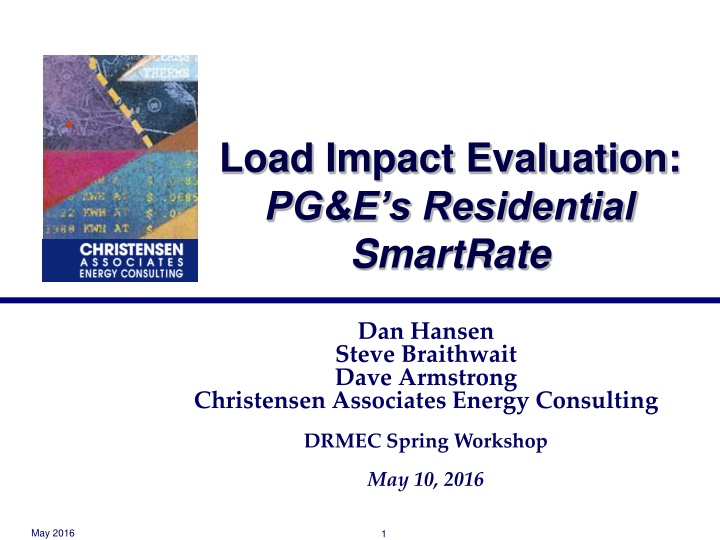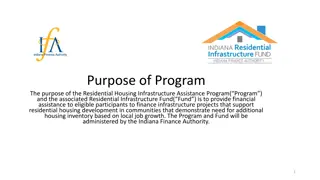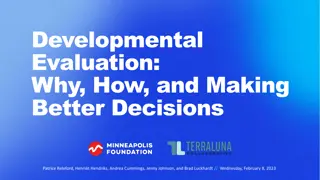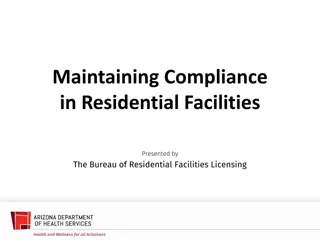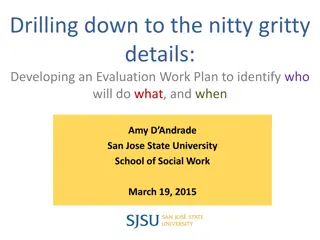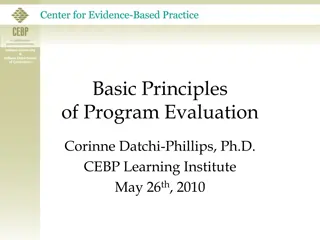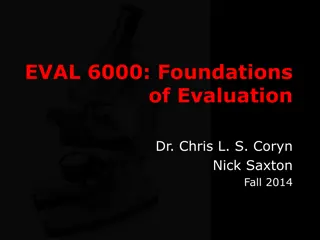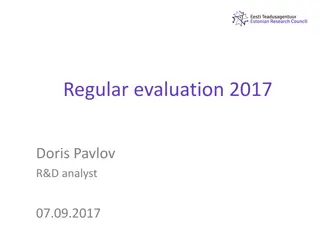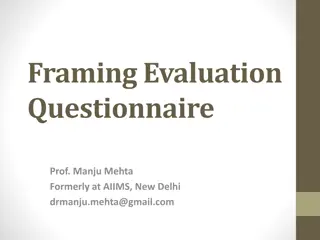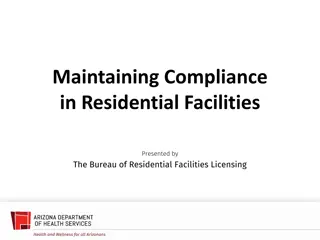PG&E Residential SmartRate Program Evaluation
This impact evaluation report assesses the effectiveness of PG&E's Residential SmartRate Program, focusing on load impacts, methodology used, program description, enrollment forecast, and results. The program involves Critical Peak Pricing, bill credits, and high-price period charges on event days. Results are based on matched control groups and difference-in-differences methodology, with a detailed analysis of load impacts on enrolled customers.
Download Presentation

Please find below an Image/Link to download the presentation.
The content on the website is provided AS IS for your information and personal use only. It may not be sold, licensed, or shared on other websites without obtaining consent from the author.If you encounter any issues during the download, it is possible that the publisher has removed the file from their server.
You are allowed to download the files provided on this website for personal or commercial use, subject to the condition that they are used lawfully. All files are the property of their respective owners.
The content on the website is provided AS IS for your information and personal use only. It may not be sold, licensed, or shared on other websites without obtaining consent from the author.
E N D
Presentation Transcript
Load Impact Evaluation: PG&E s Residential SmartRate Dan Hansen Steve Braithwait Dave Armstrong Christensen Associates Energy Consulting DRMEC Spring Workshop May 10, 2016 May 2016 1
Presentation Outline 1. Program Description 2. Ex Post Methodology 3. Ex Post Load Impacts 4. Ex Ante Methodology 5. Enrollment Forecast 6. Ex Ante Load Impacts 7. Additional Ex Post Results 8. Summary and Conclusions May 2016 2
1. Program Description Voluntary Critical Peak Pricing ( CPP ) program for PG&E s residential customers Participants receive bill credits on non-event days from June 1 through September 30 On SmartDays (hereafter called event days ), customers pay a 60 cents/kWh High-Price Period Charge from 2:00 to 7:00 p.m. Target of 12 event days per summer (max of 15) Bill protection is available through the first full season SmartRate customers can also participate in SmartAC 28% dually enrolled May 2016 3
2. Ex Post Methodology Primary results are based on a matched control group + difference-in-differences evaluation methodology Matched on event-like non-event days using Euclidean Distance Matches segmented by: SmartAC enrollment status, LCA, climate zone, CARE status, and (for dual only) CAC likelihood Two 24-hour average load profiles used: core summer days and approximate school-year days This method was chosen for two reasons: A large pool of residential (non-SmartRate) customers available from which to select matches Presence of the control group should improve load impact estimates by providing a proxy for event-day usage of similarly situated (but non-participating) customers Individual regressions are used to examine the distribution of load impacts across enrolled customers May 2016 4
3. Ex Post Load Impacts: Events SmartRate Only SmartRate + SmartAC Event Date DOW Avg. Evt. Temp. ( F) 92 95 93 98 91 96 97 92 97 91 95 95 98 97 94 Avg. Evt. Temp. ( F) 96 98 97 101 95 98 100 95 100 93 97 97 100 100 96 # Enrolled # Enrolled 12-Jun-15 25-Jun-15 26-Jun-15 30-Jun-15 1-Jul-15 28-Jul-15 29-Jul-15 30-Jul-15 17-Aug-15 18-Aug-15 27-Aug-15 28-Aug-15 9-Sep-15 10-Sep-15 12-Jun-15 All events are from 2:00 to 7:00 p.m. Notice that temperatures are higher for dually enrolled customers because of where they tend to be located (in hotter areas where the need for AC is higher). 89,045 88,435 88,413 88,248 88,178 89,444 89,634 89,799 93,496 93,850 96,355 96,590 97,521 97,613 97,704 37,607 37,215 37,146 36,989 36,938 36,611 36,573 36,545 36,364 36,336 36,262 36,254 36,069 36,044 36,016 Fri Thu Fri Tue Wed Tue Wed Thu Mon Tue Thu Fri Wed Thu Fri May 2016 5
3. Ex Post Load Impacts: Events (2) No. of Available Dispatches Hours of Availability Hours of Actual Use No. of Actual Dispatches Program Max = 15 days Min = 9 days SmartRate 75 75 15 May 2016 6
3. Ex-Post Load Impacts: Summary Key Event Hours SmartRate Only SmartRate + SmartAC Result Type Hour Type Load Impact Load Impact # Custs Temp. F # Custs Temp. F Avg. Event Hour PG&E Peak Hour CAISO Peak Hour Avg. Event Hour PG&E Peak Hour CAISO Peak Hour 19.5 92,288 94.9 20.0 36,598 97.6 Aggregate (MW) 23.4 88,248 99.0 28.8 36,989 102.4 23.7 97,613 98.7 24.3 36,044 101.1 0.21 92,288 94.9 0.55 36,598 97.6 Per 0.27 88,248 99.0 0.78 36,989 102.4 customer (kW) 0.24 97,613 98.7 0.67 36,044 101.1 PG&E peak hour = June 30, 2015, HE 18 (5 to 6 p.m.) CAISO peak hour = September 10, 2015, HE 17 (4 to 5 p.m.) May 2016 7
3. Ex Post Load Impacts: Avg. Event, SmartRate+SmartAC May 2016 8
3. Ex Post Load Impacts: Avg. Event, SmartRate Only May 2016 9
3. Ex Post Load Impacts: By Event, SmartRate+SmartAC 0.80 Average Event Load Impact (kWh per hour per customer) 0.70 0.60 0.50 0.40 0.30 0.20 0.10 - 90.0 92.0 94.0 96.0 98.0 100.0 102.0 Average Event Temp. May 2016 10
3. Ex Post Load Impacts: By Event, SmartRate Only 0.80 Average Event Load Impact (kWh per hour per customer) 0.70 0.60 0.50 0.40 0.30 0.20 0.10 - 90.0 92.0 94.0 96.0 98.0 100.0 102.0 Average Event Temp. May 2016 11
4. Ex Ante Methodology Ex-ante load impacts are developed using the ex-post load impacts from the 15 events of PY2015 Estimated the effect of weather conditions (CDD65) on per-customer load impacts For each hour of the day (24) For each LCA (8) Separately for SmartRate-only and dually-enrolled customers (2) 24 x 8 x 2 = 384 estimated models Combined estimates with the corresponding weather conditions (e.g., CAISO 1-in-2 weather conditions on an August peak day) to simulate the load impacts for every scenario / hour / customer type May 2016 12
4. Ex Ante Methodology (2) Reference loads were developed for each month and LCA using: Parameters obtained from regressions of per-customer hourly usage as a function of weather and load shape variables Ex ante weather data and day-type characteristics (e.g., temperatures on a CAISO 1-in-2 June peak day) Per-customer reference loads and load impacts are scaled using PG&E s forecast enrollments (by month, year, and dual enrollment status) May 2016 13
4. Ex Ante Methodology (3) Non-summer load impacts While we only observe summer load impacts, we are required to forecast non-summer load impacts as well (events may be called at any time of the year) Because non-summer temperatures tend to be low relative to ex-post event temperatures, simulated load impacts are correspondingly low They are defined by the constant term (a) in our estimated load impact equation (Load impact = a + b x CDD65 + e) May 2016 14
5. Enrollment Forecast SmartRate-only Dually Enrolled Total SmartRate LCA Aug. 2016 57,748 8,443 1,456 7,289 2,288 19,896 6,117 7,052 110,289 2017-2026 57,701 8,436 1,455 7,283 2,286 19,880 6,112 7,046 110,200 Aug. 2016 13,405 3,438 192 1,831 925 6,950 4,084 3,780 34,605 2017-2026 Aug. 2016 2017-2026 13,480 71,153 3,457 11,881 193 1,648 1,841 9,120 930 3,213 6,989 26,846 4,107 10,202 3,801 10,832 34,800 144,894 Greater Bay Area Greater Fresno Humboldt Kern Northern Coast Other Sierra Stockton 71,181 11,893 1,648 9,124 3,216 26,869 10,220 10,848 145,000 Total August enrollments are shown. Enrollment is forecast to remain the same from 2017 through 2026. Note that the share of dually enrolled customers is lower in the forecast period than in our ex-post analysis (~24 percent in ex ante vs. ~28 percent in ex post). This shift reduces the program-level load impact. May 2016 15
6. Ex Ante Load Impacts: Summary Event Load Load Impact % Load Impact Avg. Temp. Group Result Type Time Period # Custs Ref. Load RA Window (1-6 pm) 149.1 130.8 18.3 12.3% 93.9 Agg (MW) Event Hours (2-7 pm) 161 138.1 22.8 14.2% 93.6 110,200 SmartRate Only RA Window (1-6 pm) 1.35 1.19 0.17 Per cust (kW) Event Hours (2-7 pm) 1.46 1.25 0.21 RA Window (1-6 pm) 59.9 44 16 26.7% 98 Agg (MW) Event Hours (2-7 pm) 65.7 45.4 20.3 30.9% 98 34,800 Dual Enrolled RA Window (1-6 pm) 1.72 1.26 0.46 Per cust (kW) Event Hours (2-7 pm) 1.89 1.30 0.58 Table reflects PG&E 1in2 August peak day, 2017 to 2026. Enrollments (and therefore impacts) are constant from 2017 to 2026. Note that the RA-window load impacts are lower than the event-hour load impacts because the RA- window impacts include one non-event hour (1 to 2 p.m.). May 2016 16
6. Ex Ante Load Impacts: SmartRate Only, Ex Post vs. Ex Ante Ex Post / Ex Ante Ex Post Ex Ante Ex Post Ex Ante Reference Load 147.1 161.0 1.59 1.46 Event Load 127.6 138.1 1.38 1.25 Load Impact 19.5 22.8 0.21 0.21 % Load Impact 13.2% 14.2% Temp. ( F) 94.9 93.6 Result Type # SAIDs Aggregate (MW) Aggregate (MW) Per SAID (kW) Per SAID (kW) 92,288 110,200 Ex post reflects the average event day. Ex ante reflects PG&E 1in2 August peak day, 2017 to 2026. Both results reflect event hours (2 to 7 p.m.) for comparability. May 2016 17
6. Ex Ante Load Impacts: Dual Enrolled, Ex Post vs. Ex Ante Ex Post / Ex Ante Ex Post Ex Ante Ex Post Ex Ante Reference Load 78.7 65.7 2.15 1.89 Event Load 58.7 45.4 1.60 1.30 Load Impact 20.0 20.3 0.55 0.58 % Load Impact 25.5% 30.9% Temp. ( F) 97.6 98.0 Result Type # SAIDs Aggregate (MW) Aggregate (MW) Per SAID (kW) Per SAID (kW) 36,598 34,800 Ex post reflects the average event day. Ex ante reflects PG&E 1in2 August peak day, 2017 to 2026. Both results reflect event hours (2 to 7 p.m.) for comparability. May 2016 18
6. Ex Ante Load Impacts: SR Only, Consistency of Ex Post vs. Ex Ante 0.80 Average Event Load Impact (kWh per hour per 0.70 0.60 0.50 customer) 0.40 PG&E 1in2 August Ex Ante Forecast 0.30 0.20 0.10 - 90.0 92.0 94.0 96.0 98.0 100.0 102.0 Average Event Temp. May 2016 19
6. Ex Ante Load Impacts: Dual Enroll, Consistency of Ex Post vs. Ex Ante 0.80 Average Event Load Impact (kWh per hour per 0.70 0.60 0.50 customer) PG&E 1in2 August Ex Ante Forecast 0.40 0.30 0.20 0.10 - 90.0 92.0 94.0 96.0 98.0 100.0 102.0 Average Event Temp. May 2016 20
6. Ex Ante Load Impacts: SmartRate Only, Previous vs. Current Forecast Reference Load Event Load Load Impact % Load Impact Temp. ( F) When Created Result Type # Custs Following PY2014 (Previous) Following PY2015 (Current) PY2014 PY2015 93,800 145.3 126.9 18.4 12.7% 90.7 Agg (MW) 110,200 149.1 130.8 18.3 12.3% 93.9 1.55 1.35 1.35 1.19 0.20 0.17 Per SAID (kW) PG&E 1in2 scenario for August 2017 forecasts shown. Results shown for the RA window (1 to 6 p.m.). May 2016 21
6. Ex Ante Load Impacts: Dual Enrolled, Previous vs. Current Forecast Reference Load Event Load Load Impact % Load Impact Temp. ( F) When Created Result Type # Custs Following PY2014 (Previous) Following PY2015 (Current) PY2014 PY2015 46,200 95.7 73.2 22.6 23.6% 96.6 Agg (MW) 34,800 59.9 44.0 16.0 26.7% 98.0 2.07 1.72 1.58 1.26 0.49 0.46 Per SAID (kW) PG&E 1in2 scenario for August 2017 forecasts shown. Results shown for the RA window (1 to 6 p.m.). May 2016 22
6. Ex Ante Load Impacts: Comments Current forecast of total SmartRate load impacts for August 2017 (PG&E 1in2 peak day) is lower than previous forecast Current = 34.3 MW during RA window Previous = 40.7 MW during RA window Some of this difference can be attributed to a shift in enrollment SmartRate-only customers are now a larger share of program enrollment However, some the reduction reflects differences in the ex post load impacts PY2015 ex post load impacts are lower than those of PY2014 May 2016 23
6. Ex Ante Load Impacts: Comparison of PY2014 and PY2015 We conducted a comparison of PY2014 and PY2015 ex post load impacts Regressions (by dual enrollment status) of average event-hour load impact as a function of factors we believed could affect demand response: Weather (CDD65) Whether the prior day was also an event day ( Consecutive Event ) Whether the date is when school is in session (before mid-June or later than mid-August) Whether the date is in 2014 or 2015 May 2016 24
6. Ex Ante Load Impacts: Comparison of PY2014 and PY2015 (2) Variable SmartRate Only SmartRate + SmartAC 0.013 (0.000) 0.009 (0.356) -0.026 (0.009) -0.061 (0.001) 0.064 (0.047) 0.041 (0.000) 0.017 (0.471) -0.054 (0.026) -0.105 (0.002) -0.110 (0.246) CDD65 Consecutive Event School PY2015 Event Constant Notes: p-values in parentheses. Weather affects the load impact (not surprising). Consecutive events don t matter. Load impacts are lower when school is in session. Controlling for the above variables, PY2015 ex post load impacts are lower than PY2014. May 2016 25
6. Ex Ante Load Impacts: Comparison of PY2014 and PY2015 (3) Why were load impacts lower in PY2015? We re not entirely sure. Things that are NOT the (entire) cause of the reduction: Any variable included in the meta-analysis (weather, number of consecutive event days, number of days during school year) Increasing share of SmartRate-only customers Changes in methodology (probably) estimates appear robust to methodological changes New customers being less responsive than customers who remained in the program (there is churn in addition to the change in the overall number of enrolled customers) Possible (untested) explanation: Customers are setting their thermostat set points higher May 2016 26
7. Additional Ex Post Results: By CARE Status Aggregate Per-Customer Ref. Load (MW) Load Impact (MW) Ref. Load (kW) Load Impact (kW) Ave. Event Temp. CARE Status % Load Impact Program Enrolled Non-CARE 66,465 97.8 16.4 1.47 0.25 17% 93 SR-only CARE 25,824 49.3 3.1 1.91 0.12 6% 98 Dually enrolled Non-CARE 27,389 56.3 15.6 2.06 0.57 28% 97 CARE 9,209 22.4 4.4 2.43 0.48 20% 99 CARE customers are less responsive in both program sub-groups. May 2016 27
8. Summary and Conclusions SmartRate load impacts continue to have a strong relationship with temperatures Particularly true for customers dually enrolled in SmartAC SmartRate + SmartAC customers have both higher load impacts than SmartRate-only customers and higher post- event load increases Per-customer load impacts appear to be declining over time for reasons that are not entirely clear Perhaps caused by higher thermostat set points over time? Interesting area for further research, perhaps including surveys May 2016 28
Questions? Contact Dan Hansen, Christensen Associates Energy Consulting Madison, Wisconsin dghansen@CAEnergy.com 608-231-2266 May 2016 29
